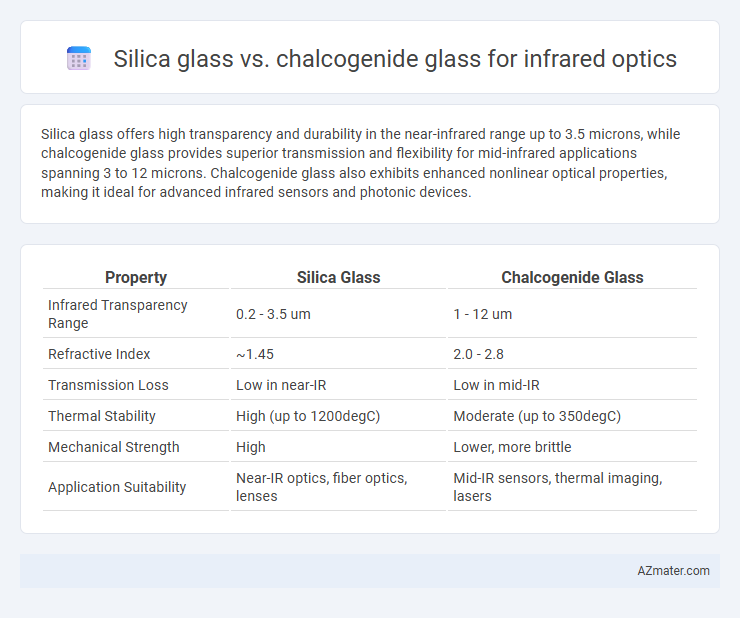Silica glass offers high transparency and durability in the near-infrared range up to 3.5 microns, while chalcogenide glass provides superior transmission and flexibility for mid-infrared applications spanning 3 to 12 microns. Chalcogenide glass also exhibits enhanced nonlinear optical properties, making it ideal for advanced infrared sensors and photonic devices.
Table of Comparison
| Property | Silica Glass | Chalcogenide Glass |
|---|---|---|
| Infrared Transparency Range | 0.2 - 3.5 um | 1 - 12 um |
| Refractive Index | ~1.45 | 2.0 - 2.8 |
| Transmission Loss | Low in near-IR | Low in mid-IR |
| Thermal Stability | High (up to 1200degC) | Moderate (up to 350degC) |
| Mechanical Strength | High | Lower, more brittle |
| Application Suitability | Near-IR optics, fiber optics, lenses | Mid-IR sensors, thermal imaging, lasers |
Introduction to Infrared Optics
Silica glass and chalcogenide glass are essential materials for infrared optics, with silica glass offering excellent transparency in the near-infrared region up to about 2.5 microns, while chalcogenide glass extends performance into the mid- to far-infrared range from around 2 to 12 microns. Infrared optical systems rely on these glasses for applications such as thermal imaging, spectroscopy, and fiber optics, where material transparency and refractive index critically influence system efficiency and resolution. The choice between silica and chalcogenide glass depends largely on the specific infrared wavelength requirements and environmental conditions of the application.
Overview of Silica Glass
Silica glass, composed primarily of silicon dioxide (SiO2), is widely used in infrared optics due to its excellent transparency in the near-infrared region up to about 3.5 micrometers and superior thermal stability. Its low optical loss, high mechanical strength, and resistance to environmental degradation make it ideal for fiber optics and precision lenses in telecommunications and sensing applications. However, silica glass exhibits limited transmission beyond mid-infrared wavelengths, where chalcogenide glasses offer better performance.
Overview of Chalcogenide Glass
Chalcogenide glass, composed primarily of sulfur, selenium, and tellurium, offers superior infrared transmission beyond the 2-12 micrometer range, unlike silica glass which is limited to about 2.5 micrometers. Its high refractive index and excellent thermal stability make it ideal for mid- to far-infrared optical components in sensors and thermal imaging systems. Chalcogenide glass also demonstrates strong infrared transparency and low phonon energy, enabling efficient optical performance in infrared spectroscopy and military applications.
Infrared Transmission Properties
Silica glass exhibits strong infrared transmission primarily in the near-infrared region up to around 2.5 microns, making it suitable for applications requiring transparency in the visible to near-IR spectrum. Chalcogenide glass, composed of elements like sulfur, selenium, and tellurium, offers extended infrared transmission from approximately 2 to 12 microns or more, enabling superior performance in mid- to far-infrared optics. The broader infrared transmission window of chalcogenide glass makes it ideal for thermal imaging, sensing, and spectroscopy where silica's limited IR transparency is insufficient.
Thermal and Mechanical Stability
Silica glass offers superior thermal stability with a high melting point around 1713degC, making it ideal for high-temperature infrared optics applications, while chalcogenide glass has lower thermal resistance, typically softening between 200-400degC. Mechanically, silica glass exhibits excellent hardness and chemical durability, ensuring long-term structural integrity, whereas chalcogenide glass is more prone to deformation and surface damage due to its softer and more fragile nature. Therefore, silica glass provides enhanced performance in environments demanding robust thermal and mechanical stability.
Optical Performance and Dispersion
Silica glass offers excellent transparency in the near-infrared range up to about 2.5 microns with low optical loss and minimal chromatic dispersion, making it ideal for high-performance fiber optics and lenses. Chalcogenide glass extends infrared transmission significantly beyond 12 microns, providing superior infrared transparency and strong nonlinear optical properties, although it exhibits higher material dispersion and absorption than silica. The choice between silica and chalcogenide glass hinges on the required infrared wavelength range and dispersion control, with silica favored for low-loss, low-dispersion near-IR applications and chalcogenide preferred for mid- to far-infrared optics despite increased dispersion challenges.
Environmental Resistance and Durability
Silica glass exhibits superior environmental resistance and mechanical durability in infrared optics, maintaining stability under high temperatures and exposure to moisture, chemicals, and UV radiation. Chalcogenide glass offers extended infrared transmission but is more vulnerable to oxidation, moisture absorption, and thermal degradation, necessitating protective coatings or controlled environments for long-term performance. The choice between silica and chalcogenide glasses depends on application-specific durability requirements and operating conditions in harsh or variable environments.
Manufacturing and Cost Considerations
Silica glass offers well-established manufacturing processes with high purity and uniformity, making it cost-effective for large-scale infrared optics production, especially in the near-infrared range. Chalcogenide glass, although more expensive due to complex synthesis and difficulty in handling its sensitivity to moisture and thermal properties, excels in mid to far-infrared applications where silica's transmission is limited. Manufacturing chalcogenide glass requires specialized techniques such as vacuum melting and rapid quenching, contributing to higher costs but enabling customized optical components for advanced infrared technologies.
Typical Applications in Infrared Systems
Silica glass is widely used in infrared optics for applications requiring high transmission in the near-infrared region, such as fiber optics, laser delivery systems, and protective windows in sensing devices. Chalcogenide glass excels in mid- to far-infrared applications due to its broader transmission range and higher refractive index, making it ideal for thermal imaging, chemical sensing, and infrared spectroscopy. These materials are selected based on specific wavelength ranges and environmental durability requirements in advanced infrared systems.
Choosing Between Silica and Chalcogenide Glass
Silica glass exhibits excellent transparency in the near-infrared range (0.8-2.5 mm) with high durability and thermal stability, making it ideal for applications requiring robustness and low loss. Chalcogenide glass extends infrared transmission significantly into the mid-infrared region (2-12 mm), offering superior infrared sensitivity but with lower mechanical strength and higher susceptibility to environmental degradation. Selecting between silica and chalcogenide glass depends on the required infrared wavelength range, environmental conditions, and application-specific performance criteria in infrared optics.

Infographic: Silica glass vs Chalcogenide glass for Infrared optics
 azmater.com
azmater.com